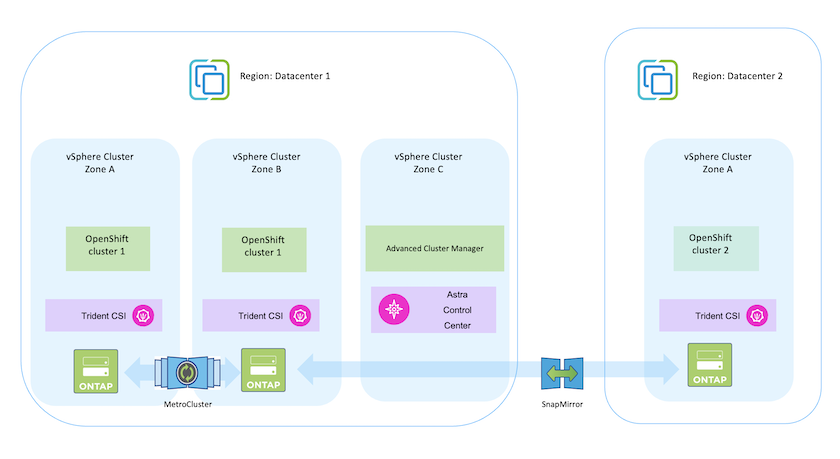Deploy and configure the Red Hat OpenShift Container platform on VMware
 Suggest changes
Suggest changes


This section describes a high-level workflow of how to set up and manage OpenShift clusters and manage stateful applications on them. It shows the use of NetApp ONTAP storage arrays with the help of Trident to provide persistent volumes.

|
There are several ways of deploying Red Hat OpenShift Container platform clusters. This high-level description of the setup provides documentation links for the specific method that was used. You can refer to the other methods in the relevant links provided in the resources section. |
Here is a diagram that depicts the clusters deployed on VMware in a data center.

The setup process can be broken down into the following steps:
Deploy and configure a CentOS VM
-
It is deployed in the VMware vSphere environment.
-
This VM is used for deploying some components such as NetApp Trident and NetApp Trident Protect for the solution.
-
A root user is configured on this VM during installation.
Deploy and configure an OpenShift Container Platform cluster on VMware vSphere (Hub Cluster)
Refer to the instructions for the Assisted deployment method to deploy an OCP cluster.

|
Remember the following: - Create ssh public and private key to provide to the installer. These keys will be used to login to the master and worker nodes if needed. - Download the installer program from the assisted installer. This program is used to boot the VMs that you create in the VMware vSphere environment for the master and worker nodes. - VMs should have the minimum CPU, memory, and hard disk requirement. (Refer to the vm create commands on this page for the master and the worker nodes which provide this information) - The diskUUID should be enabled on all VMs. - Create a minimum of 3 nodes for master and 3 nodes for worker. - Once they are discovered by the installer, turn on the VMware vSphere integration toggle button. |
Install Advanced Cluster Management on the Hub cluster
This is installed using the Advanced Cluster Management Operator on the Hub Cluster.
Refer to the instructions here.
Install two additional OCP clusters (Source and Destination)
-
The additional clusters can be deployed using the ACM on the Hub Cluster.
-
Refer to the instructions here.
Configure NetApp ONTAP storage
-
Install an ONTAP cluster with connectivity to the OCP VMs in VMWare environment.
-
Create an SVM.
-
Configure NAS data lif to access the storage in SVM.
Install NetApp Trident on the OCP clusters
Deploy an Application on Source Cluster
Use OpenShift GitOps to deploy an application. (eg. Postgres, Ghost)
The next step is to use the Trident Protect for Data protection and Data migration from the source to the destination cluster.
Refer here for instructions.


